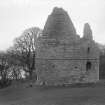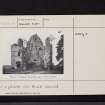Pricing Change
New pricing for orders of material from this site will come into place shortly. Charges for supply of digital images, digitisation on demand, prints and licensing will be altered.
Littledean Tower
Tower House (Medieval)
Site Name Littledean Tower
Classification Tower House (Medieval)
Alternative Name(s) Littledean Castle
Canmore ID 57227
Site Number NT63SW 16
NGR NT 63287 31324
Datum OSGB36 - NGR
Permalink http://canmore.org.uk/site/57227
- Council Scottish Borders, The
- Parish Maxton
- Former Region Borders
- Former District Ettrick And Lauderdale
- Former County Roxburghshire
Littledean Tower lies close to the site of an old ford across the River Tweed, and is provided with excellent natural defences to the north and west.
Occupying the site of an earlier fort of probable prehistoric date, it consists of the ruins of a four-storeyed tower-house of sixteenth-century date, which shows clear evidence of two phases of building.
The main feature of the second phase has been a substantial and unusual D-shaped tower, a bastion-like addition which was clearly built to increase its defensive capabilities, perhaps in response to an English raid in 1544. The lower floors of this addition are bristling with numerous gunloops, which would have enabled the defenders to cover all angles of the approach in the event of an attack.
The 'tower and fortalice' of Littledean was associated with the Kers of Littledean, and became the centre of their barony of Maxton. It appears to have formed their principal residence until the eighteenth century. Local tradition states that the site was abandoned in favour of nearby Nenthorn when the head of the household was gored to death by a prize bull.
Text prepared by RCAHMS as part of the Accessing Scotland's Past project
NT63SW 16 63287 31324
For surrounding (earthwork) fort, see NT63SW 51.
(NT 6328 3132) Littledean Tower (NR) (In Ruins).
OS 6" map, Roxburghshire, (1924).
Littledean Tower: This ruin, standing on the high right bank of the Tweed a mile and a half NE of Maxton and immediately below an old ford, includes work of two different building-periods, both apparently within the 16th century. The earlier portion was an oblong main block of four storeys, to the W end of which has been added a massive tower (RCAHMS 1956, fig.53) shaped like the letter D, today a mere shell. All that is left of the main block are the W ends of the side walls. These walls are built of freestone rubble, with ashlar dressings at the voids, which had chamfered arrises. In the S wall the original entrance is still to be seen, built up, and with a gun-loop inserted in the infilling to protect the later entrance in the adjoining E wall of the tower; above the earlier entrance there is an original window, also altered when the addition was made. This entrance opened directly into a vaulted storeroom, but there is nothing to show how the upper storeys were reached nor how they were arranged.
Although the tower, with its height of four storeys and a garret, was added primarily for defence, much additional accommodation was also obtained. Like the older part it is mainly rubble-built, only the straight E wall, in which the entrance is set, being of ashlar. At ground level it has a chamfered base-course; immediately above this runs a series of six oval gun-loops, while a second tier, also six in number, occurs on the first floor and a single gun-loop opens into the staircase at an intermediate level. The lowest storey has no windows other than a single tiny slit set high up, but the first floor has four small windows, none of which, however, faces W, the direction of approach. Above their lintels the tower is encircled by a bold roll-shaped string-course supporting, near the NE angle, the moulded framework of an armorial panel which no longer exists. Midway between the string-course and the wall-head appear the three windows of the second floor, all having a quirked edge-roll on their jambs and lintels. The parapet-walk has been supported on separate double-membered corbels. Within it rise the remains of three crow-stepped gables, in which the tower originally finished, all of them being built on the inner side of the wall to give more room to the parapet-walk. The upper windows are either rounded or chamfered on their jambs and lintels.
The entrance to the tower (RCAHMS 1956, fig. 323) has been provided with two doors, and is surmounted by a window with a quirked edge-roll and-hollow moulding on its jambs and lintel. It opens into a vaulted lobby, on the N side of which a door has been broken out to give access to the vaulted storeroom of the older part of the house, while from the inner end of this lobby an angled passage leads through the stair-well into a quadrant-shaped compartment in the undercroft of the tower. This last was originally vaulted and from it four gun-loops still open, but apart from these the only light was obtained through a slit 3 1/2ins wide, set high up and facing NNW. Between this room and the stair must lie another vaulted chamber, but its access cannot be traced without excavation. The staircase led first to a little room above the last, now represented only by its outer wall, which shows a window and two gun-loops. It then gave access to a room of irregular shape, evidently the kitchen as it has a large fireplace on the W. and a slop-sink on the NE. The kitchen has two windows and also three gun-loops, one of them placed in the back of the fireplace. The first doorway opening off the staircase above the entrance to the kitchen led into the old part of the house, and higher up is the access to a little vaulted room above the entrance-lobby. This has a locker in one wall and is lit from the E. The stair itself is lit from a window set high up with a steeply sloped breast. On the second floor of the tower the arrangement seen below is repeated, a living-room with a fireplace lying above the kitchen; but on the third floor, which lay at the level of the parapet-walk, there were two rooms above the living-room, each with a fireplace, while the garret was also provided with one. It is to be noted that socket-holes, intended to house the ends of gun-mountings, can be seen at the necks of some of the gun-loops mentioned above.
There seems to have been a barmkin attached to the tower.
Marcus Ker of Litil Dene is on record in 1525. (Reg Magni Sig Reg Scot 1513-1546). In 1550 he resigned the lands of Maxton and those of Litill Dene "cum turre, fortalicio" to his son and heir Andrew. (Reg Magni Sig Reg Scot 1546-1580). These entries seem to indicate that the tower was added by the middle of the 16th century; and the date can perhaps be fixed to within six years by the fact that in 1544, when the hall and stables were burned, the "stone house" escaped because it was "mured" with earth. (J Morton 1832). This stone house was presumably the
earlier portion of the existing ruin. In 1587-8, when Maxton was granted to Walter Ker as a free barony, it was laid down that the tower and manor of Littildane was to be the principal messuage. Reg Magni Sig Reg Scot 1580-1593). At a much earlier period Littledean was the
birth-place of Duns Scotus. (W M Mackenzie 1948).
RCAHMS 1956, visited 8 July 1932.
The remains of this tower are as described above, but no trace of the barmkin mentioned was seen.
Visited by OS (WDJ) 13 September 1962.
Note (2 November 2015)
This monument was delisted and was removed from the list of buildings of special architectural or historic interest.
The structure is still designated as a scheduled monument under the Ancient Monuments and Archaeological Areas Act 1979.
Information from Historic Environment Scotland, 2 November 2015
Sbc Note
Visibility: This is an upstanding building.
Information from Scottish Borders Council.












































































